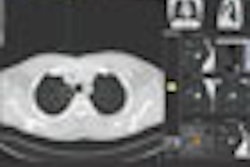The costs of following up extracolonic lesions found at virtual colonoscopy will be substantial, and very likely higher than what has been reported in previous studies, researchers from Wake Forest University Baptist Medical Center said last month at the American College of Gastroenterology's annual scientific meeting in Las Vegas.
"There are good things and bad things about extracolonic findings," co-investigator Dr. Richard Bloomfeld told AuntMinnie.com in an interview. "Our conclusion is that there are significant costs to the evaluation of extracolonic findings -- in contrast to the widely quoted $28 to $34" additional cost per VC patient.
Several early studies calculated what are probably unrealistically low follow-up costs for the extracolonic findings, said Bloomfeld, who is a gastroenterologist at the medical center and assistant professor of internal medicine at Wake Forest University in Winston-Salem, NC. The lead investigator in the study was Dr. James Kimberly, an assistant professor of internal medicine at Wake Forrest, who provided additional information about the results to AuntMinnie.com by e-mail.
Among the early VC cost studies, Gluecker and his team found that 10% of 681 patients had extracolonic findings of high clinical importance. Follow-up exams added $34 per study, they reported (Gastroenterology, April 2003, Vol. 124:4, pp. 911-916). Studies by Rajapaksa et al (Journal of Clinical Gastroenterology, October 2004, Vol. 38:9, pp. 767-771), and Hara et al (Radiology, May 2000, Vol. 215:2, pp. 353-357) each calculated an additional cost of $28 per VC finding.
The Wake Forest researchers generated their cost estimates from a combined VC and optical colonoscopy project conducted between 2002 and 2003, aimed at evaluating the sensitivity and specificity of VC with and without oral contrast, compared to those of conventional colonoscopy. The cost analysis was prepared as an adjunct to that study.
Costs of clinical visits, imaging and laboratory studies, and medical procedures generated as a result of extracolonic findings at VC were all included in the tally. In all, 143 mostly asymptomatic and average-risk screening subjects (48% male, median age 57) underwent virtual colonoscopy followed by same-day conventional colonoscopy. (Overall, 13% had reported symptoms, including a change in bowel habits in 6%, abdominal pain in 8%, and rectal bleeding in 3%.)
The abstract, submitted early for the conference, showed data for the first 136 of the 143 subjects. Of these, 134 subjects or 98% had at least one extracolonic finding. The most common findings causing further evaluation were lung nodules and indeterminate kidney lesions, Kimberly wrote in an e-mail.
Extracolonic findings were reported in all but two patients, stratified into high (n = 25, 17.5%), moderate (n = 35, 24.5%), and low (n = 74, 51.7%) clinical importance. Subsequent workup was performed in 32 subjects, or 24% of all study participants, including 56% of those with findings of high importance (n = 14), 43% of those with moderately important findings (n = 15) and 4% (n = 3) of those with findings of low clinical importance, the group reported.
Findings deemed of high importance included 23 lung nodules, one renal mass, and one markedly thickened terminal ileum. The 74 moderately important findings ranged from indeterminate kidney lesions (n = 11) to indeterminate gastric masses (n = 4), to indeterminate liver lesions (n = 3) to lytic or sclerotic bone lesions (n = 3).
Over a mean of 38 months after virtual colonoscopy, the subjects underwent 73 imaging studies including 37 CT exams, 16 ultrasound studies, six abdominal MRI scans, 13 x-rays, and one intravenous pyelogram. Divided among the entire study population, the cost was $185 per patient for imaging.
Also ordered were 30 laboratory studies, 44 clinic visits, and six medical procedures including two gastroscopies, two cystoscopies, one bronchoscopy, and one laparoscopy. Lab results added an additional $8 per patient, lead investigator Kimberly explained.
For all the needed follow-up, the researchers calculated a total additional cost of $31,411, or $231 per patient. Not a single cancer or other critical finding resulted from the follow-up. The radiologists who evaluated the CT data were experienced and well-trained, Bloomfeld said.
Since the abstract was written, the costs for the last seven subjects have been tallied, along with some additional medical costs uncovered for the group as a whole, raising even this total by several dollars per patient. The final numbers will be included in the manuscript the group is preparing for publication, Bloomfeld said.
Would an additional $231 or even $241 per exam make VC too expensive to perform, considering that VC is generally cheaper than optical colonoscopy?
"My answer is no, that's not a deal killer," Bloomfield said. "But people think that ($28-$34) is the correct range ... and that's way too low."
He may have a point. A recent paper by Xiong et al studied 225 patients with VC; 116 or 53% had extracolonic findings. The group included the cost of therapy as well as follow-up, which together added $279 to each exam (British Journal of Radiology, July 5, 2006).
Ultimately, what will make VC cost-effective or not is the threshold for referring patients to optical colonoscopy, which is tied to the size of polyps screening subjects are willing to "walk around with" in a VC polyp surveillance protocol, Bloomfeld said.
For example, if only patients with 9-mm polyps are referred for optical colonoscopy, the costs of VC screening will be reasonable, he said. But if patients with 5-mm lesions insist on having them removed immediately at optical colonoscopy, VC will not be cost-effective.
And although the Wake Forest team found no lesions of high clinical importance, Bloomfeld is confident that "if you do enough of these you will find (abdominal aortic aneurysms) and renal cell carcinomas and that will help people," he said.
Despite the potential benefits of detecting extracolonic findings, there are additional risks of morbidity and mortality that come from looking for them, Bloomfeld noted. And telling subjects the potential findings in the study took "a psychological toll," he said; many subjects missed work for the extra tests.
Before VC is performed on potentially millions of individuals of screening age, reporting standards should be established not only for polyp sizes, but for incidental findings, Bloomfeld said.
Radiologists have begun the process with a proposed virtual colonoscopy reporting system called C-RADS (Radiology, July 2005, Vol. 236:1, pp. 3-9).
When faced with extracolonic lesions on the CT data, too many radiologists fail to make a clear recommendation to either follow-up or not follow up, according to Bloomfeld. This can lead to primary care doctors ordering additional tests that are unnecessary and potentially risky, he said.
"The costs need to be understood, and radiologists ... need to standardize reporting to minimize unnecessary exams for the detection of extracolonic findings," he said.
By Eric Barnes
AuntMinnie.com staff writer
November 3, 2006
Related Reading
Extracolonic lesions: Find them if you can, October 30, 2006
Extracolonic findings double VC costs, but might be worth paying, July 20, 2006
Serious extracolonic findings prevalent in screening, symptomatic VC patients, August 17, 2005
VC shows extracolonic findings in most patients, July 28, 2005
VC with contrast finds more extracolonic trouble, April 11, 2005
Copyright © 2006 AuntMinnie.com



















